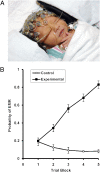Newborn infants learn during sleep
- PMID: 20479232
- PMCID: PMC2890482
- DOI: 10.1073/pnas.1005061107
Newborn infants learn during sleep
Abstract
Newborn infants must rapidly adjust their physiology and behavior to the specific demands of the novel postnatal environment. This adaptation depends, at least in part, on the infant's ability to learn from experiences. We report here that infants exhibit learning even while asleep. Bioelectrical activity from face and scalp electrodes was recorded from neonates during an eye movement conditioning procedure in which a tone was followed by a puff of air to the eye. Sleeping newborns rapidly learned the predictive relationship between the tone and the puff. Additionally, in the latter part of training, these infants exhibited a frontally maximum positive EEG slow wave possibly reflecting memory updating. As newborns spend most of their time sleeping, the ability to learn about external stimuli in the postnatal environment during nonawake states may be crucial for rapid adaptation and infant survival. Furthermore, because eyelid conditioning reflects functional cerebellar circuitry, this method potentially offers a unique approach for early identification of infants at risk for a range of developmental disorders including autism and dyslexia.
Conflict of interest statement
The authors declare no conflict of interest.
Figures


References
-
- Bosma JF. In: Oral Sensation and Perception: The Mouth of the Infant. Charles C. Thomas., editor. Springfield, IL: 1972.
-
- Papousek H. Conditioned head rotation reflexes in infants in the first months of life. Acta Paediatr. 1961;50:565–576. - PubMed
-
- DeCasper AJ, Fifer WP. Of human bonding: Newborns prefer their mothers’ voices. Science. 1980;208:1174–1176. - PubMed
-
- Moon C, Bever TG, Fifer WP. Canonical and non-canonical syllable discrimination by two-day-old infants. J Child Lang. 1992;19:1–17. - PubMed
-
- Siqueland ER, Lipsitt LP. Conditioned head-turning in human newborns. J Exp Child Psychol. 1966;3:356–376. - PubMed
Publication types
MeSH terms
Grants and funding
LinkOut - more resources
Full Text Sources
Research Materials

